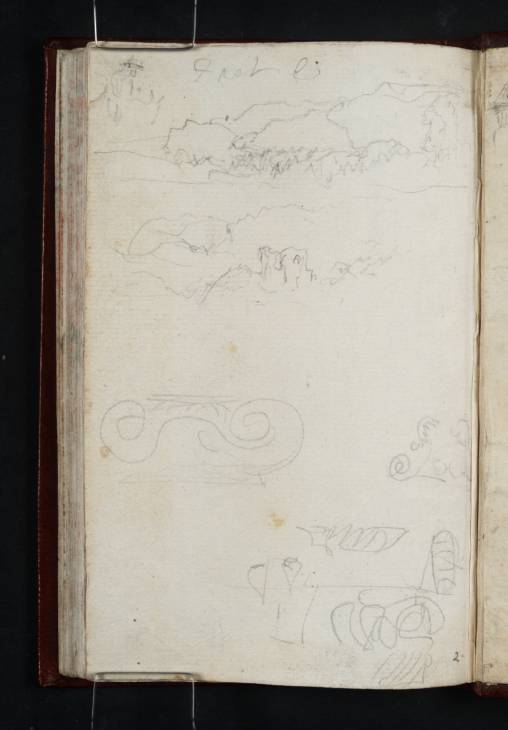Joseph Mallord William Turner Fast Castle 1818
Image 1 of 2
Joseph Mallord William Turner,
Fast Castle
1818
Joseph Mallord William Turner 1775–1851
Folio 68 Verso:
Fast Castle 1818
D13444
Turner Bequest CLXV 66a
Turner Bequest CLXV 66a
Pencil on white laid paper, 159 x 99 mm
Inscribed in pencil by Turner ‘Fast C’ top left; in pencil in another hand ‘2’ bottom right
Inscribed in pencil by Turner ‘Fast C’ top left; in pencil in another hand ‘2’ bottom right
Accepted by the nation as part of the Turner Bequest 1856
References
1909
A.J. Finberg, A Complete Inventory of the Drawings of the Turner Bequest, London 1909, vol.I, p.480, CLXV 66a, as ‘“Fast Castle,” &c. (A loose leaf which may have belonged to this book.)’.
This page, drawn with the sketchbook turned to the left, has been used for a number of quick sketches. At the top are two rough sketches that were identified by Finberg, based on the inscription, as Fast Castle.1 The Castle, now just a few ruins, sits on a headland to the north-west of St Abbs on the East Lothian coast. Turner seems to have covered most of the coast between St Abb’s Head and North Berwick, and probably made these sketches on the way north between the two (folio 2; D13324; CLXV 2).
Fast Castle was engraved for Scott’s Provincial Antiquities by William Miller based on Revd John Thomson’s painting, 1823 (National Galleries of Scotland),2 and it is possible that Turner considered making his own design. The existence of only two rapid sketches on this page can be explained by Turner’s tight schedule with much to see on the east coast before reaching Edinburgh. However, considering the number of sketches he made of Dunbar, Bass Rock and Tantallon, for example, the existence of only these two Fast Castle sketches suggests that Turner did not expect to illustrate the subject, and only sketched it en route for future reference.
Turner had made sketches of Fast Castle in the Dunbar sketchbook, 1801 (for example, Tate D02732; Turner Bequest LIV 76a), and he returned in 1822 (King’s Visit to Scotland sketchbook, Tate D13716; Turner Bequest CC5) and 1831 (Berwick sketchbook, Tate D25732; Turner Bequest CCLXV 49), suggesting that the subject held a private interest unconnected to the Provincial Antiquities.
The top sketch shows Fast Castle Head, the headland upon which the ruin stands: a jumble of craggy rocks covered in grass. The small sketch in the top left may show the castle itself. Below is a sketch of the ruin, drawn in a similar way to the rocks with a simple broken outline. At the bottom of the page is a series of sketches of architectural details. Most prominent and recognisably is an ionic capital, drawn upside–down with its distinctive scroll design. To its right is a smaller sketch of another capital with a more complex design also incorporating scrolls. The sketches at the bottom right are perhaps details of mouldings or other architectural ornamentation. All of these were presumably taken from a particular building in Edinburgh, but it is not impossible that they were sketched at another time when this sketchbook came to hand.
Thomas Ardill
November 2007
Engraved by William Miller after Revd John Thomson of Duddingston, Provincial Antiquities and Picturesque Scenery of Scotland, number X, 1826; Scott’s interest in Fast Castle probably stemmed from the fact that Mary Queen of Scots stayed there in 1566. The castle also featured in his 1819 novel, The Bride of Lammermoor, where it is referred to as Wolf’s Crag.
How to cite
Thomas Ardill, ‘Fast Castle 1818 by Joseph Mallord William Turner’, catalogue entry, November 2007, in David Blayney Brown (ed.), J.M.W. Turner: Sketchbooks, Drawings and Watercolours, Tate Research Publication, December 2012, https://www


